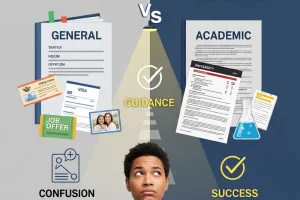Preparing for your test for IELTS can feel overwhelming, but you’re not alone in this journey. As someone who’s guided hundreds of students through their test for IELTS preparation, I know exactly what you’re going through – the late-night study sessions, the anxiety about band scores, and that nagging question: “Am I really ready?”
The truth is, excelling in your test for IELTS isn’t just about proving your English skills; it’s about demonstrating that you can thrive in real-world English-speaking environments. Whether you’re eyeing a spot at Oxford, planning to work in Canada, or dreaming of life in Australia, your test for IELTS score is the key that unlocks these opportunities.
Why Your Test for IELTS Strategy Needs to Be Different in 2025
Let’s talk honestly about what makes the test for IELTS challenging. It’s not just another language exam you can cram for. The test for IELTS evaluates how naturally you communicate, how well you understand cultural nuances, and whether you can handle real-life situations in English.
I’ve noticed that students who simply memorize answers or rely on outdated preparation methods often plateau around Band 6. But those who approach their test for IELTS as a communication challenge? They consistently hit Band 7 and above.
What your test for IELTS actually measures:
- Listening: Can you follow conversations in multicultural workplaces?
- Reading: Do you grasp the main ideas in academic journals or workplace memos?
- Writing: Can you express complex ideas clearly and professionally?
- Speaking: Do you communicate naturally and confidently?
The test for IELTS comes in two versions, and choosing the right one matters:
Test for IELTS Academic
Essential for university admissions, featuring academic texts and formal writing tasks
Test for IELTS General Training
Perfect for immigration and work visas, focusing on practical, everyday English
Section-by-Section Test for IELTS Mastery
Conquering the Test for IELTS Listening Section
Your test for IELTS Listening section can be tricky because it mirrors real-life audio challenges. You’ll hear four recordings with different accents, background noise, and speaking speeds – just like in actual English-speaking environments.
My proven test for IELTS Listening strategy:
Start with what I call “accent diversity training.” Many test-takers practice only with standard British or American accents, then panic when they hear Australian or Canadian speakers during their actual test for IELTS.
Here’s my daily routine that boosted my students’ Listening scores:
Morning (15 minutes):BBC World Service news – trains your ear for formal, clear pronunciation
Afternoon (20 minutes):Australian podcasts like “Conversations” – gets you comfortable with different intonation patterns
Evening (15 minutes):Canadian radio shows – helps with varied speaking speeds
The prediction technique that changed everything:
During your test for IELTS, you get time to preview questions. Use those seconds wisely! If you see questions about university accommodation, prime your brain for words like “deposit,” “lease,” “utilities,” or “flatmates.”
Real student success story:
Sarah from Vietnam struggled with the Listening section, scoring only 5.5 in practice tests. After following this accent-diversity approach for six weeks, she scored 7.0 on her actual test for IELTS.
Mastering Test for IELTS Reading Comprehension
The Reading section of your test for IELTS isn’t about understanding every word – it’s about efficient information processing. I’ve seen too many students get bogged down trying to comprehend complex sentences when they should be scanning for specific details.
Test for IELTS Reading Academic challenges:
- • Dense passages from scientific journals
- • Complex data interpretation
- • Abstract concepts and theories
Test for IELTS Reading General Training focus:
- • Workplace documents and policies
- • Advertisements and instruction manuals
- • General interest articles
My scanning method for test for IELTS Reading success:
- 1. The 45-second preview: Before reading, scan headings, subheadings, and any visual elements
- 2. Question-first approach: Read all questions before touching the passage
- 3. Keyword transformation: IELTS loves synonyms! “Automobile” in the question might be “vehicle” in the text
Vocabulary building that actually works:
Instead of memorizing word lists, I recommend “contextual vocabulary expansion.” Read articles from The Guardian, Scientific American, or The Economist – these publications match the complexity and style you’ll encounter in your test for IELTS.
Pro tip: Create a “synonym journal.” When you encounter words like “substantial” in practice materials, note alternatives like “significant,” “considerable,” or “major.” This directly improves your test for IELTS Reading performance.
Excelling in Test for IELTS Writing Tasks
This is where many test-takers stumble, and I completely understand why. Your test for IELTS Writing section isn’t just about grammar and vocabulary – it’s about communicating effectively in academic or professional contexts.
Test for IELTS Academic Writing Task 1 (Data description):
Think like a business analyst presenting quarterly results. You need to:
- Identify key trends and patterns
- Make relevant comparisons
- Use varied vocabulary for increases/decreases
- Maintain an objective, analytical tone
Sample phrases that work:
- “The data reveals a marked increase…”
- “What’s particularly noteworthy is…”
- “This trend contrasts dramatically with…”
IELTS General Training Writing Task 1 (Letters):
Success here depends on matching your tone to the context. A complaint letter uses formal language, while a note to a friend is conversational.
IELTS Writing Task 2 (The essay worth 66% of your Writing score):
Here’s my framework that consistently produces Band 7+ scores:
The POWER Structure:
- Position: State your thesis clearly
- Outline: Preview your main arguments
- Work through: Develop each point with examples
- Evaluate: Address counterarguments
- Reinforce: Strong, memorable conclusion
Personal experience:
One student, Ahmad from Jordan, jumped from Band 6.0 to 8.0 in Writing by incorporating specific, current examples instead of generic statements. Instead of writing “Many people use social media,” he wrote “According to Statista’s 2024 report, 4.8 billion people actively use social media platforms.”

Dominating the Test for IELTS Speaking Section
Your IELTS Speaking test is an 11-15 minute conversation that feels more natural than other standardized tests. The examiner wants to see your personality, not just your grammar knowledge.
- IELTS Speaking Part 1 (4-5 minutes): Personal introduction and familiar topics
- IELTS Speaking Part 2 (3-4 minutes): Individual presentation on a cue card topic
- IELTS Speaking Part 3 (4-5 minutes): Abstract discussion related to Part 2
My storytelling approach for IELTS Speaking success:
Instead of giving basic answers, create mini-narratives. This technique transformed my students’ Speaking scores because it showcases natural fluency and vocabulary range.
Example transformation:
❌ Basic answer:
“I like cooking because it’s relaxing.”
✅ Engaging response:
“Cooking has become my sanctuary, especially after discovering that kneading bread dough somehow melts away work stress. Last weekend, I spent three hours making pasta from scratch – my kitchen looked like a flour bomb had exploded, but the satisfaction of creating something delicious with my own hands was incredible.”
Fluency strategies for your IELTS test:
- Use filler phrases naturally: “That’s a fascinating question…” or “From my perspective…”
- Develop opinions on common topics beforehand (technology, environment, education)
- Practice explaining personal experiences with rich details
Cultural Fluency: Your Secret Test for IELTS Advantage
Here’s what separates Band 7+ candidates from the rest: cultural intelligence. Your test for IELTS isn’t just measuring language – it’s evaluating whether you can communicate effectively in English-speaking cultures.
Cultural awareness examples:
British understatement: “It’s quite good” often means “It’s not very good”
North American directness: Being straightforward is valued over being overly polite
Australian informality: Casual communication doesn’t mean unprofessional
Building cultural fluency for your test for IELTS:
- Media immersion: Watch shows from different English-speaking countries
- Online communities: Join Reddit discussions or Facebook groups from target countries
- News diversity: Read BBC (British perspective), CBC (Canadian), ABC Australia, and NPR (American)
Real-world application:
During your test for IELTS Speaking section, referencing cultural knowledge naturally impresses examiners. Instead of generic examples, mention specific cultural practices or current events from English-speaking countries.
Test for IELTS Preparation: Daily Habits That Actually Work
Forget expensive courses that promise overnight success. Your test for IELTS preparation should integrate naturally into your daily routine:
Morning routine (20 minutes):
- Listen to English news while having breakfast
- Read headlines from major English newspapers
- Practice describing your daily schedule aloud
Commute time:
- English podcasts for Listening practice
- Mental note-taking on overheard conversations
- Vocabulary review using smartphone apps
Evening practice (30 minutes):
- Write journal entries about your day
- Record yourself discussing current events
- Complete one section of practice tests
Weekend deep dives:
- Full-length practice tests under timed conditions
- Analysis of mistakes and improvement areas
- Extended reading of academic or general interest articles
Advanced Test for IELTS Strategies from Top Scorers
Time management secrets:
- Test for IELTS Listening: Use transfer time wisely to review answers
- Test for IELTS Reading: Allocate exactly 20 minutes per passage
- Test for IELTS Writing: Spend 5 minutes planning, never skip this step
- Test for IELTS Speaking: Use preparation time in Part 2 to organize thoughts, not memorize scripts
Common pitfalls to avoid:
- Over-preparing with memorized responses (examiners can detect this instantly)
- Focusing only on accuracy while ignoring fluency
- Neglecting cultural context in answers
- Spending too much time on difficult questions
Band 8+ secrets:
- Use idiomatic expressions naturally, not forcefully
- Show range in vocabulary without showing off
- Demonstrate critical thinking skills, especially in Speaking Part 3
- Maintain consistency across all four skills
Your Test for IELTS Success Timeline
8 weeks before:Take diagnostic test, identify weak areas, begin daily practice routine
6 weeks before:Focus intensively on problem areas, incorporate cultural learning
4 weeks before:Complete full practice tests weekly, refine time management
2 weeks before:Fine-tune strategies, maintain confidence, avoid learning new material
Test week:Light practice, rest well, visualize success
Final Test for IELTS Preparation Thoughts
Your test for IELTS journey is ultimately about proving you can communicate effectively in English-speaking environments. Every strategy in this guide – from accent diversity training to cultural fluency development – serves that larger goal.
Remember, the best preparation for your test for IELTS happens when you stop thinking of it as just a test and start seeing it as a communication challenge. The skills you develop won’t just help you achieve your target band score; they’ll serve you throughout your academic career, professional life, and personal relationships in English-speaking countries.
Start implementing these strategies today. Your future self – whether studying at Cambridge, working in Sydney, or building a life in Toronto – will thank you for the effort you put into your test for IELTS preparation now.
Ready to begin your test for IELTS success story? The journey starts with your next practice session.




